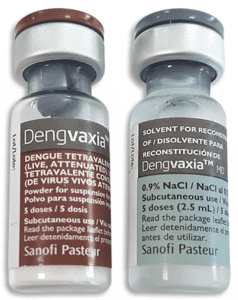

Dengue fever, caused by dengue virus (DENV), is of substantial public health significance in the tropics, where the virus is spread by Aedes mosquitoes. Last week the FDA announced its approval of a first vaccine for the prevention of dengue disease in endemic areas.
The vaccine approved by the FDA is Dengvaxia, a live-attenuated formulation manufactured by Sanofi Pasteur that is administered in three doses, at six month intervals. The use of this vaccine is restricted to individuals who were previously infected with DENV. This is because naïve vaccine recipients who have not had a prior natural infection with DENV can experience enhanced dengue disease if they are naturally infected after vaccination. As discussed in two previous posts and at least one episode of TWiV (links available here, here, and here), Dengvaxia is only moderately effective and is unsuitable for children under the age of 9, a demographic that is in dire need of a dengue vaccine in endemic countries.
There are four serotypes of DENV; DENV-1, -2, -3, and -4. An initial infection with any of these viruses can range from asymptomatic to severe, with symptoms such as skin rash, fever, headache, vomiting, muscle and joint pains often collectively referred to as “breakbone fever.” This first infection provides life-long immunity against the infecting serotype, but only poor short-term immunity against the other three (heterotypic) serotypes. A second infection with a heterotypic serotype can cause severe complications, characterized by bleeding, hemorrhagic fever and shock. This enhanced disease, known as antibody-dependent enhancement, is a hallmark of dengue disease and is a phenomenon in which antibodies against a heterotypic virus bind it but don’t neutralize (i.e., inactivate) it. Instead, they facilitate and enhance entry of the heterotypic virus into host cells, resulting in increased viral replication and disease. Dengvaxia presumably mimics an initial natural exposure in naïve recipients, so that a subsequent natural infection could potentially cause severe disease via antibody-dependent enhancement. For this reason Dengvaxia is contraindicated for people who have never had a DENV infection.
For many viruses, antibodies are sufficient to protect against infection and/or disease. However, some viruses can only be cleared from the body through cell-mediated immunity, involving the action of phagocytes, antigen-specific cytotoxic T lymphocytes, and cytokines. It is currently unknown whether protection from DENV infection requires the presence of neutralizing antibodies, cell-mediated immunity, or both. The limited success achieved with induction of DENV-specific antibody responses suggests that inactivation of DENV may also require induction of CD8+ T lymphocytes (cell-mediated immunity). Dengvaxia is based on an existing live-attenuated vaccine for yellow fever virus (YFV) and consists of four YFV genomes that have been chimerized by replacing the YFV pre-membrane and envelope structural genes with those of the four respective DENV serotypes. Because YFV and DENV are both members of the family Flaviviridae,and because the DENV envelope protein is the major target of neutralizing antibody, this strategy would normally make sense. However, because the DENV epitopes that the CD8+ T lymphocytes would recognize are absent in this vaccine, Dengvaxia does not confer any CD8-mediated immunity against DENV. Dengvaxia thus does not elicit a possibly critical element of the immune response.
An effective DENV vaccine would generate a robust tetravalent response to all four serotypes at the same time, thus avoiding issues of antibody-dependent enhancement. That is, by eliciting a strong response to all four DENV types, there wouldn’t be the possibility of a weakly neutralizing antibody for one serotype causing a severe infection by that virus. Although achieving a robust tetravalent response has been a challenge, there are several vaccine candidates in the works that look promising. TV003, a live-attenuated tetravalent formulation developed by the National Institutes of Health, is currently being evaluated in phase 2 and phase 3 clinical trials. Unlike in Dengvaxia, the four components in TV003 are based entirely on the DENV genome, as follows. Each component represents one of the four DENV serotypes and consists of a DENV genome containing a 30 nucleotide deletion in the 3′ untranslated region, for the purpose of attenuating virulence. Because vaccine efficacy against DENV-2 has been historically poor, the genome representing this serotype is actually a DENV-2/DENV-4 chimera and consists of a DENV-4 backbone harboring the DENV-2 pre-membrane and envelope genes. The DENV-3 component also contains an extra 31 nucleotide deletion in the 3′ untranslated region, in addition to the 30 nucleotide deletion present in the other three vaccine components. A single dose of this TV003 vaccine was 74% effective in inducing antibody responses against each of the four serotypes in human subjects. TV005, a formulation containing the same components as TV003 but having a 10-fold higher dose of the DENV-2/DENV-4 chimera, was even more effective. A single dose of TV005 elicited an overall tetravalent neutralizing antibody response of 90%.
Other vaccine candidates in the pipeline include another live-attenuated tetravalent vaccine named DENVax, a formalin-inactivated virus vaccine, and a subunit virus vaccine comprising recombinant envelope protein.
Because of the potential for enhanced disease in naïve recipients of Dengvaxia, the FDA’s approval of this vaccine is not only inappropriate but also untimely in view of growing global anti-vaccine sentiments. It is difficult for vaccine advocates to make a valid case for the safety of vaccines if the FDA endorses a vaccine that is, in fact, not safe for people who have never had the disease. Hopefully one of the pending candidate vaccines will soon be licensed for public use and replace Dengvaxia. In the interim, those receiving Dengvaxia should be pre-screened to ensure that they have previously been infected with DENV.

Pingback: A risky vaccine - Virology Hub